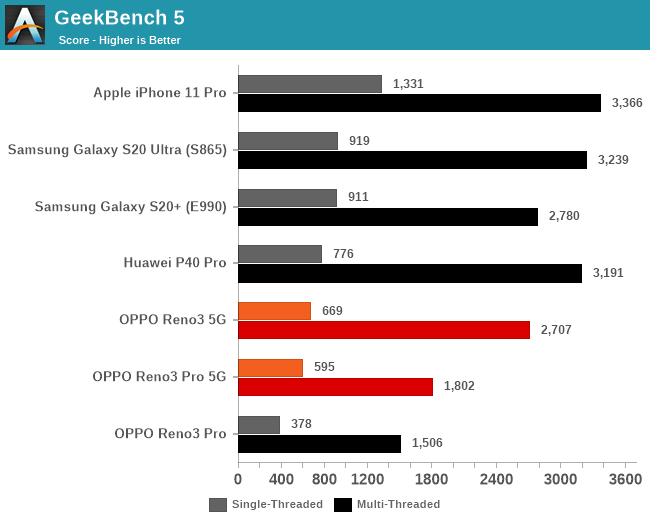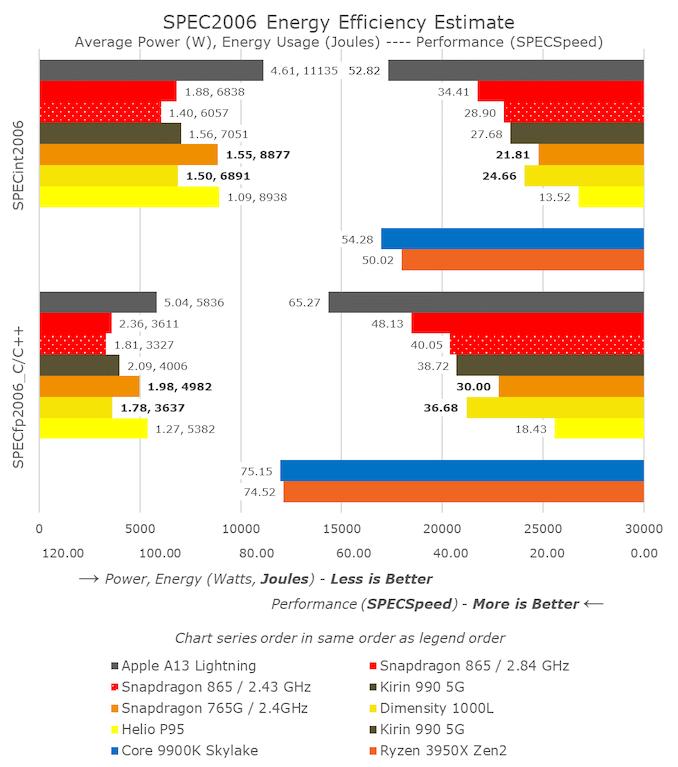OPPO's Reno3 5G vs Reno3 Pro vs Reno3 Pro 5G: Why Don't We See More MediaTek Dimensity 1000 Phones?
by Andrei Frumusanu on August 10, 2020 10:00 AM ESTSnapdragon 765G vs Dimensity 1000L
The positioning of the Snapdragon 765 Reno3 Pro 5G versus the Dimensity 1000L Reno3 5G is an extremely interesting one. By all means, the regular Reno3 is supposed to be the lower-end device and in fact does cost less than the Pro variant of the phone. Logically, we would expect OPPO here to choose the lower-end SoC for the Reno3 whilst the Reno3 Pro gets the better performing chipset. Although that’s what everybody would assume at first glance, things aren’t quite as straightforward.
The although the two devices and SoCs are seemingly positioned close to each other, they’re very different in terms of CPU capabilities. There are two factors at play here: first of all, the MediaTek chipset outright has a core-count advantage over the Qualcomm design by simply having four big cores instead of only two. That’s already a major difference and usually the kind of differentiation you’d expect from SoC at different class categories.
Secondly, MediaTek’s design uses newer Cortex-A77 cores whilst the Snapdragon uses last year’s Cortex-A76 IP. The Cortex-A77 is generally 25% better clock-for-clock compared to its predecessor, which seemingly compounds the processing power ability difference between the two SoCs and Reno3 phones. Qualcomm does have an advantage in terms of clocks speeds which does slightly make up some of this difference: at 2.4GHz on one of the Cortex-A76 cores it’s 200MHz ahead of the MediaTek chipset, which should reduce the expected performance gap a little bit.
Another big difference between the two SoCs is the fact that MediaTek uses TSMC’s 7nm node, while the Snapdragon 765 is manufactured on Samsung’s 7LPP node, with the only other public silicon out there manufactured on this process technology being Samsung’s own Exynos chipsets.
Comparing single-threaded performance between the two SoCs, we see the expected performance gap between the two designs materialise in the measured results. In SPEC2006, the Dimensity 1000L outperforms the S765 by respectively 13% and 22% in the integer and floating-point suites.
Furthermore, the Dimensity-powered Reno3 5G is able to do this whilst consuming less power and energy than the Qualcomm chipset. Generally, we expect this difference to be process-node related as we highly suspect Samsung’s 7nm node being less power efficient than TSMC’s process technology.

Whilst we don’t usually run SPEC in rate mode (multi-process test), GeekBench5 very much showcases the multi-threaded performance advantage that the MediaTek-powered Reno3 5G has over the Reno3 Pro 5G: With a score of 2702, it’s 50% faster than the 1802 score of the Snapdragon 765.
The one area where I did note that the Snapdragon chipset outperforms the Dimensity counterpart is memory latency. On the part of the CPUs, the Qualcomm chipset seemingly has a lower latency memory subsystem that allows it roughly a 13% latency advantage in full random DRAM memory accesses – or around 22ns at a test depth of 128MB.
The memory characteristics between the two SoCs are quite different, as the MediaTek chipset does showcase stronger CPU-side memory bandwidth, particularly in memory reads that reach up to 19GB/s versus 13.3GB/s for the Qualcomm chipset, with a similar advantage in memory copies, although the Snapdragon seems to have faster accesses and more bandwidth for memory writes.
All in all, until now it seems that the MediaTek powered chipset has a clear advantage in terms of performance and power efficiency, which actually makes sense as the Dimensity 1000L on paper just is a higher specced piece of silicon.












44 Comments
View All Comments
s.yu - Monday, August 10, 2020 - link
Reno 3 ProSheep. Whoever buys that device for the Pro moniker thinking its gonna be better has got to be pro at being sheep.mfaisalkemal - Monday, August 10, 2020 - link
Hi Andrei,I think IMG A-Series 2.5x improvement claim still impressive because at 12nm(iso node process, area and power like Helio P90) compared to snapdragon 765g at 7nm.If I multiply 2.5 times to your all GPU benchmarks, IMG A-Series ahead all snapdragon 765g scores except Aztec ruin(I hope A-Series architecture have improvement on that benchmark compared to PowerVR GM9446).
Do you know how many peak system active power(minus screen power) of Reno 3 pro(Helio p95) Andrei?
Beaver M. - Tuesday, August 11, 2020 - link
The hardware is often excellent on these Chinese phones. No matter if Oppo, Xiaomi, Huawei, etc.But the software and its support is horrible. The customization of Android is horribly buggy and overdone, especially the power saving "features". They often offer whitelists for apps, but they actually dont work. Not even Gmail is working in the background, not to mention apps from 3rd parties. They even end background apps automatically after a few hours or days without you realizing. Imagine someone for example with diabetes using and 3rd party app for alarms...
And then of course the support ends very quickly (around 2 years) and even simple security patches often break a lot.
Sad, really. A real waste.
I had high hopes in BQ, a Spanish producer, because their support and small customizations of Android were absolutely awesome, not to say perfect. But they got bought by a Vietnamese corporation and stopped producing phones after that.
Retycint - Tuesday, August 11, 2020 - link
Do you actually have any sources for your claims? As far as I am aware, the software support for Xiaomi flagships, at least, are pretty good. The Android version may not be updated that much but the features trickle in via MIUI updates so it doesn't really matterRetycint - Tuesday, August 11, 2020 - link
For instance, the Mi MIX 2 released in 2017 September is still slated to receive the latest MIUI. That's literally 3 years of software support, which is something only matched by Pixel and OnePlus (and Samsung, but only their newer devices)Beaver M. - Tuesday, August 11, 2020 - link
I had several Huawei, Honor, Xiaomi, Oppo and others.Sure, sometimes after many months a few get a security patch. Like the Honor 9 from 2017 lately, that didnt get a security patch since July 2019, and then suddenly got the May 2020 security update and some added features. But thats really nothing to be proud of. You cant really take that for granted either. It pretty much happens randomly.
sonny73n - Tuesday, August 11, 2020 - link
Of course he does not have any evident or source to back up his claims. He’s just like other Apple sheep thinking that every “security” update is actually security update.Beaver M. - Wednesday, August 12, 2020 - link
Oh, so someone who hasnt owned anything Apple since 2008 and most likely wont ever again, is an "Apple sheep."Makes sense, sonny. :thumbsup:
Ptosio - Wednesday, August 12, 2020 - link
Which makes you wonder: what won't these manufacturers release more pure Android headsets? It shouldn't be so hard...flyingpants265 - Tuesday, August 11, 2020 - link
Boycott this phone, Realme X is the same thing for $142 USD. Artificially limited and sold in Asia only or something.